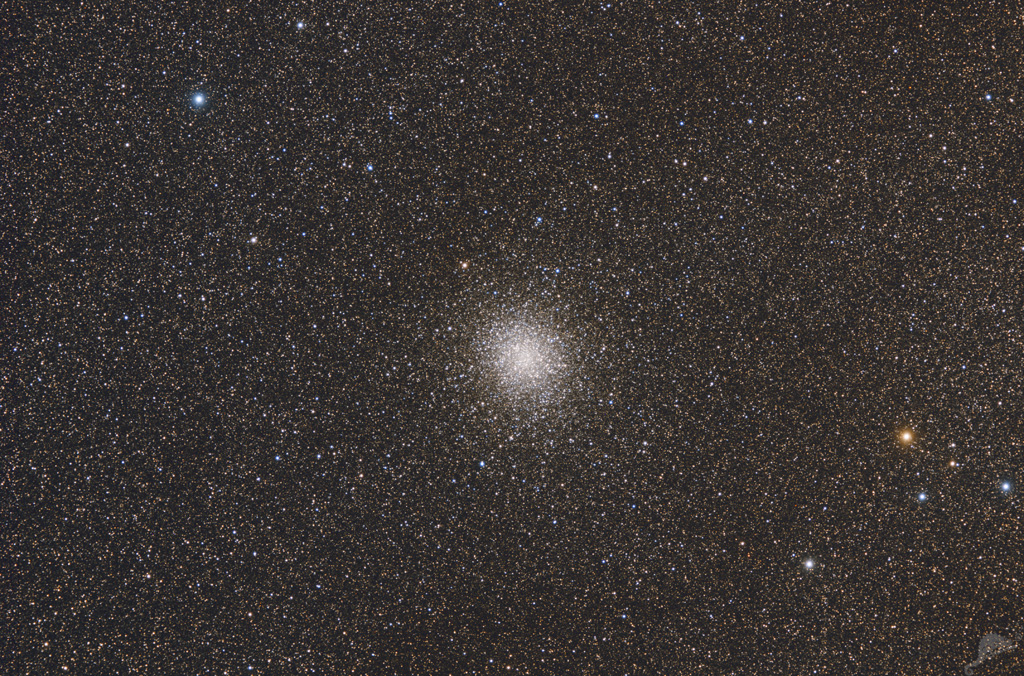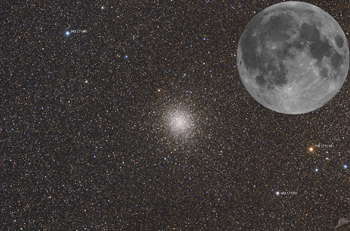 |
CHAMÄLEON + ONJALA OBSERVATORY DeepSky | SITEMAP HOME CHAMÄLEON |
|
 |
|||
| « back to overview Cluster | Load
higher resolution (1800 x 1200 Pixel 3500 x 2300 Pixel) |
Object description |

Messier 22 (NGC 6656) is considered one of the most magnificent globular clusters in the entire sky. It is located in the constellation Sagittarius and is surpassed in apparent size and brightness only by Omega Centauri (NGC 5139) and 47 Tucanae (NGC 104). Under dark skies it is clearly visible to the naked eye.
At a distance of about 10,500 light-years, it is also one of the closest globular clusters to the solar system. With an apparent diameter of 17 arcminutes, M 22 fills a spatial volume of nearly 100 light-years. The cluster contains about 100,000 stars, among them more than 100 variable stars and 2 black holes with 10 to 20 solar masses each. According to Shapley it is assigned to concentration class VII.
Dense preceding interstellar dust causes a reddening of the light and makes the stars of the cluster appear more yellowish than they would be without dust. (E(B-V) = 0.34 mag). A large fraction of the many faint stars in our image belong to the so-called galactic bulge, a bulge of the Milky Way around the galactic center at a distance of about 27,000 light-years. Seen from Earth, Messier 22 lies in front of the bulge of our Milky Way.
In 48 B.C., Chinese astronomers observed a new star in the constellation Sagittarius for a few days. For the Far Eastern astronomers it was another representative of those "guest stars" which they could observe again and again. Only modern astronomy realized that the briefly shining stars were due to nova or supernova explosions.
In April 2019, an international group of astronomers published the discovery of the remnant of a nova's explosion near the center of M 22. In a nova, hydrogen ignites on the surface of a white dwarf star, increasing the star's brightness by a factor of ten thousand or more for a few days. The remnant is a reddish luminous nebula of hydrogen and other gases about 8000 astronomical units in diameter. The mass of the nebula is estimated to be about 30 Earth masses. This discovery confirmed one of the oldest recorded observations of an astronomical event outside our solar system.
 |
An
abstract and the complete publication
can be found at this link. An image showing the nova
position in M 22
can be viewed here. The discovery is attributed to Abraham Ihle on August 26, 1665. Ihle was an amateur astronomer and a postal clerk by profession. That night Ihle wanted to observe Saturn with a 2 inch telescope and noted a small faint nebula at the position of M 22. Only Wilhelm Herschel recognized in M 22 a dense cluster of faint stars and his son John Herschel described it as a "splendid globular cluster, gradually brightening towards the center, but not condensing into a nucleus". « Click here or the thumbnail to load a large annoted image and a size comparison to the full moon. |
 |
 |
 |
 |
 |
 |
 |
| Sun | Moon | Solar System | DeepSky | Widefield | Miscellaneous | Spec. Projects |